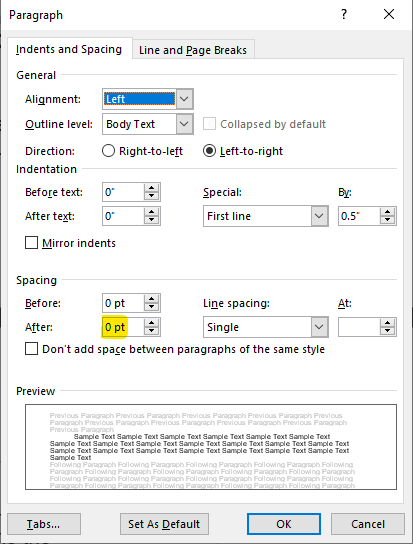Style manuals often require that footnotes be single spaced but have a blank line between them.1
This is true for SBL style if you’re a student.2 It’s also true if you use Turabian.3
You can insert this blank line a few different ways. Unfortunately, two of the more common ones can have undesirable side effects.
How Not to Space Footnotes
The two ways to space footnotes that might be most apparent are to:
- Enter an extra paragraph after each footnote or
- Format each footnote paragraph to insert extra space after it.
But each of these methods has downsides. These can cost you additional time if you want to avoid a mess at the bottom of a page.
What’s Wrong with Extra Paragraphs
If you decide to space your footnotes by inserting a new paragraph after each one (e.g., by pressing “Enter”), you can end up with a few different problems.
First, you have to manually enter the new paragraph after each footnote. So if you forget one, it won’t be there.
Second, your extra paragraph can move from after the last footnote on a page to above the first footnote on the next page.
This happens when there’s too much text on the page where the note starts to accommodate the full note and the extra paragraph that follows it. When this happens, you get an extra blank line that shouldn’t be there between the footnote rule and the first footnote on that next page (see below).
Third, Word uses a “continuation rule” whenever a footnote comes over from the bottom of one page to the next. By default, the continuation rule runs the full width of the page rather than just the first few inches.
So if your blank paragraph comes over from one page onto the next, you’ll also see the continuation rule when you shouldn’t. You’ll then get something that looks like this.

Fourth, in order to avoid these issues, you have to pay attention to the spacing after each footnote. As you edit, you may need to manually insert or remove extra paragraphs to avoid the problems they create.
All of this takes time and attention away from much more significant things you could be focusing on instead.
What’s Wrong with Formatting Each Footnote
You’re probably familiar with single or double spacing within a paragraph. But Word also allows you to insert extra space before or after a paragraph.
You can do this from the paragraph formatting dialog box. Footnotes are no exception.

You can even add spacing to all your footnotes at once with this method if you click into a given footnote, select all the footnotes (e.g., Ctrl+A), and then add the appropriate number of points after the footnote paragraphs.
If you space your footnotes using this method, you’ll get a lot fewer problems than you will with entering extra paragraphs.
In particular, Word will know that the extra space “attaches” only to the bottom of a footnote and so won’t allow just an extra blank line to roll over to the top of the footnote section on a following page.
The main downside of adding spacing via the paragraph dialog box is that your extra lines apply only once you’ve formatted each footnote paragraph individually.
In large part, you can avoid this being a problem by formatting your footnote to include extra space after them only in bulk when you think you’re finished editing.
But even then, if you continue editing and insert a new footnote, you’ll need to format that footnote as well.
So this method improves on the first but still requires you to “babysit” your footnotes more than you really need to.
Conclusion
In short, either of these common ways to space footnotes can get you a blank line between notes in a document.
They just require more hassle and cajoling than they’re worth.
Thankfully, there’s a better way to space between notes. This involves editing the style that drives those notes’ formatting in the first place.

Tired of fighting with Word? Want to be done with frustrated hours fussing over how to get the formatting you need?
My new guide shows you how to bypass all of this so you can let Word work for you while you focus on your research.

For students in any graduate program, mastering the full range of available research tools is crucial for efficient and consistent productivity. Dr. Stark has mastered these tools—the most important of which is Microsoft Word…. Students eager to take their work to the next level would do well to follow Dr. Stark’s in-depth guidance.
Header image provided by Fabien Barral. ↩
See the Student Supplement for The SBL Handbook of Style, §3.3. ↩
See Manual for Writers, 9th ed. (affiliate disclosure), §16.3.4.1. ↩

Leave a Reply